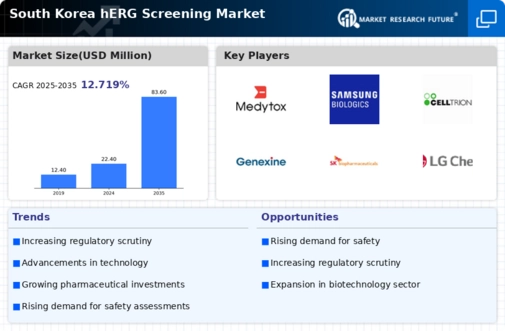Increased Investment in Drug Development
The herg screening market is benefiting from increased investment in drug development within South Korea. As pharmaceutical companies strive to bring innovative therapies to market, the need for comprehensive safety assessments has become paramount. In 2025, the total expenditure on drug development is expected to exceed $2 billion, with a significant portion allocated to herg screening. This trend indicates a growing recognition of the importance of early-stage safety evaluations in the drug development process. Consequently, the herg screening market is likely to expand as companies seek to mitigate risks associated with drug candidates. Enhanced collaboration between academia and industry is also anticipated, fostering advancements in herg screening methodologies and technologies, which may further drive market growth.
Rising Demand for Cardiac Safety Testing
The herg screening market in South Korea is experiencing a notable increase in demand for cardiac safety testing. This surge is primarily driven by the growing awareness of the risks associated with drug-induced arrhythmias. Regulatory bodies are emphasizing the importance of thorough cardiac safety evaluations, leading to a heightened focus on herg screening. In 2025, the market is projected to reach approximately $50 million, reflecting a compound annual growth rate (CAGR) of around 8%. Pharmaceutical companies are increasingly investing in herg screening technologies to ensure compliance with safety regulations, thereby propelling the market forward. As the industry evolves, the integration of advanced screening methods is likely to enhance the accuracy and efficiency of cardiac safety assessments, further solidifying the herg screening market's position in the broader pharmaceutical landscape.
Collaboration Between Industry and Academia
Collaboration between industry and academia is emerging as a key driver for the herg screening market in South Korea. Partnerships between pharmaceutical companies and research institutions are fostering innovation and advancing screening methodologies. In 2025, it is anticipated that collaborative research initiatives will account for nearly 25% of herg screening projects, enhancing the quality and reliability of testing. These collaborations often lead to the development of novel screening technologies and improved data analysis techniques, which can significantly impact drug safety evaluations. As the herg screening market continues to evolve, such partnerships are likely to play a crucial role in addressing the challenges associated with cardiac safety assessments, ultimately benefiting both the industry and public health.
Technological Integration in Screening Processes
Technological integration is transforming the herg screening market in South Korea. The adoption of high-throughput screening technologies and automated systems is streamlining the testing process, allowing for faster and more accurate results. In 2025, it is estimated that around 30% of herg screening tests will utilize automated platforms, significantly improving efficiency. This shift towards automation not only reduces labor costs but also enhances the reproducibility of results, which is crucial for regulatory compliance. As the industry embraces these technological advancements, the herg screening market is likely to witness substantial growth. Furthermore, the incorporation of artificial intelligence and machine learning in data analysis may provide deeper insights into drug interactions, potentially revolutionizing the screening landscape.
Growing Regulatory Pressure for Safety Assessments
The herg screening market is increasingly influenced by growing regulatory pressure for safety assessments in South Korea. Regulatory agencies are mandating comprehensive evaluations of drug candidates to ensure patient safety, particularly concerning cardiac risks. This trend is evident in the tightening of guidelines surrounding herg screening, which necessitates more rigorous testing protocols. In 2025, it is projected that compliance costs for pharmaceutical companies will rise by approximately 15%, prompting a greater reliance on herg screening services. As a result, the market is expected to expand as companies prioritize adherence to these regulations. The emphasis on safety assessments is likely to drive innovation in herg screening methodologies, fostering a more robust and reliable market.


















Leave a Comment